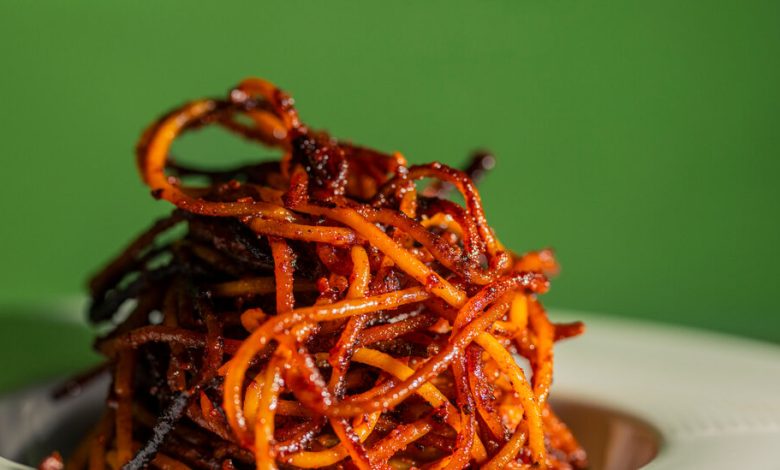It’s the Flavor That Slays in This Killer Pasta

When it comes to cooking pasta, Celso Laforgia breaks every rule in the book. His spaghetti isn’t ivory-colored and tender. It’s dark as polished ebony and it crunches like grissini. He doesn’t cook it in boiling water. He chars the raw noodles in a skillet. He seasons it not with the usual fresh garlic, but with powdered, and if that’s not iconoclastic enough here in southern Italy, his restaurant, Urban L’Assassineria Urbana in the pulsing city of Bari in Apulia, serves such decidedly un-Italian dishes as tacos and bao.
But to come to Bari without sampling this spaghetti all’Assassina would be like visiting Rome and missing the Colosseum.
Recipe: Spaghetti all’Assassina (Spicy Singed Tomato Pasta)
It’s a tall tight coil of spaghetti that’s audibly crisp, the individual strands charred and smoky. The intensely concentrated, unmistakably homemade tomato sauce has been cooked right into the pasta, not tossed with it or ladled on top.
“To be honest, I didn’t invent spaghetti all’Assassina,” Mr. Laforgia said. Nonetheless, he has emerged as its most famous practitioner — thanks in part to his appearance last year on Stanley Tucci’s CNN show “Searching for Italy.” Mr. Laforgia now serves 700 to 1,000 orders a week, and he estimates 10 percent of his customers are American.
The dish has been a favorite in Bari for more than 50 years. Vincenzo Rizzi, the Bari-born weekly restaurant columnist for the Corriere del Mezzogiorno, traces it to 1967 and Enzo Francavilla of the Osteria al Sorso Preferito. “One evening, the chef prepared a dish of very spicy and slightly burnt spaghetti with tomato sauce for some customers,” Mr. Rizzi said. “It was probably burned by mistake, but the diners seemed to like it.”
“You’re trying to kill us” the customers joked on account of the charred noodles and fiery chiles and called the dish spaghetti all’Assassina, which translates to “killer spaghetti.” The recipe was inherited by the restaurant’s longtime current owner, Pierino Lonigro, and it remains a house specialty to this day.
Its preparation uses a cooking technique called “risottatura,” said Elizabeth Minchilli, who runs food tours in Bari and Puglia. Often, dried spaghetti are pan-fried raw with garlic and chiles, just as you’d sizzle arborio rice in oil to start a risotto. You gradually stir in liquid (salted water and tomato sauce, in this case), simmering the spaghetti to the firmer side of al dente. In this, it’s not unlike fideos, the Spanish pasta dish that’s cooked like paella.
But unlike risotto, which you cook until creamy (all’onda — wavelike, as Italians like to say), you continue cooking Assassina until the sauce is completely absorbed and the spaghetti begins to char. A slosh of olive oil and couple deft flips of the pan, and it’s ready.
At Urban L’Assassineria Urbana, Mr. Laforgia serves nontraditional versions, too, such as Assassina 2.0 (topped with stracciatella), Alla Puttanesca (lit up with olives, capers and anchovies) and the perennially popular Alla San Juannidde (named for St. John and garnished with anchovies, pesto and confit cherry tomatoes).
Not everyone approves of these innovations. Sandro Romano, the director of the Oraviaggiando Italian restaurant guide prefers the original recipe to the variations. “My personal opinion is that it is not good for tradition and that burning everything is extreme,” he said. “Plus it negates the complexity of Bari’s culinary tradition.”
For the moment, spaghetti all’Assassina remains a Bari specialty — but maybe not for long. Mr. Laforgia plans to open a second Urban L’Assassineria Urbana in Milan. And his ultimate dream: to bring the dish to New York.
Ilaria Parogni contributed translation.
Follow New York Times Cooking on Instagram, Facebook, YouTube, TikTok and Pinterest. Get regular updates from New York Times Cooking, with recipe suggestions, cooking tips and shopping advice.





